Roast chicken is a staple in many home cooks’ kitchens. Not only is using the oven a great way to cook without having to constantly keep watch, but it is also a healthier alternative to sauteeing and frying. Another benefit kicks in when you know how to roast a whole chicken – cost-effectiveness.
Chicken is already a pretty affordable protein choice, but buying whole chickens often makes even more sense economically (depending on how you’ll be using the chicken). If you need chicken for soup or to make sandwiches, roasting then carving the whole chicken works wonders. If you’re having a family dinner and each of you prefers a different part of the chicken, a whole chicken makes a lot of sense.
After just a few easy prep steps and about an hour (or approximately 15 minutes for each lb. the chicken weighs), you’ve got a juicy, crispy-skinned, intensely flavorful whole chicken to enjoy in a variety of ways for two or three days (at least!)
Ingredients you’ll need
Produce
- Yellow onion
- Fresh rosemary
- Fresh thyme
- Lemon
- Garlic
Baking & Pantry Items
- Extra virgin olive oil
- Kosher salt
- Fresh ground black pepper
- Creole seasoning (optional)
- Garlic powder
- Onion powder
- Smoked paprika
- Dried oregano (optional)
- Dried thyme (optional)
Dairy
- Unsalted buttered (only needed if you’re not using olive oil)
Meat
- Whole chicken
Equipment you’ll need
- Cutting board and butchering scissors or knife
- Small mixing bowl (for dry rub)
- Kitchen twine
- Roasting pan
- Rack for roasting pan (doesn’t have to be the exact one that comes with the roasting pan, but just anything that will elevate the chicken from the bottom of the roasting pan)
- Brush or bulb baster
How to prep a whole chicken
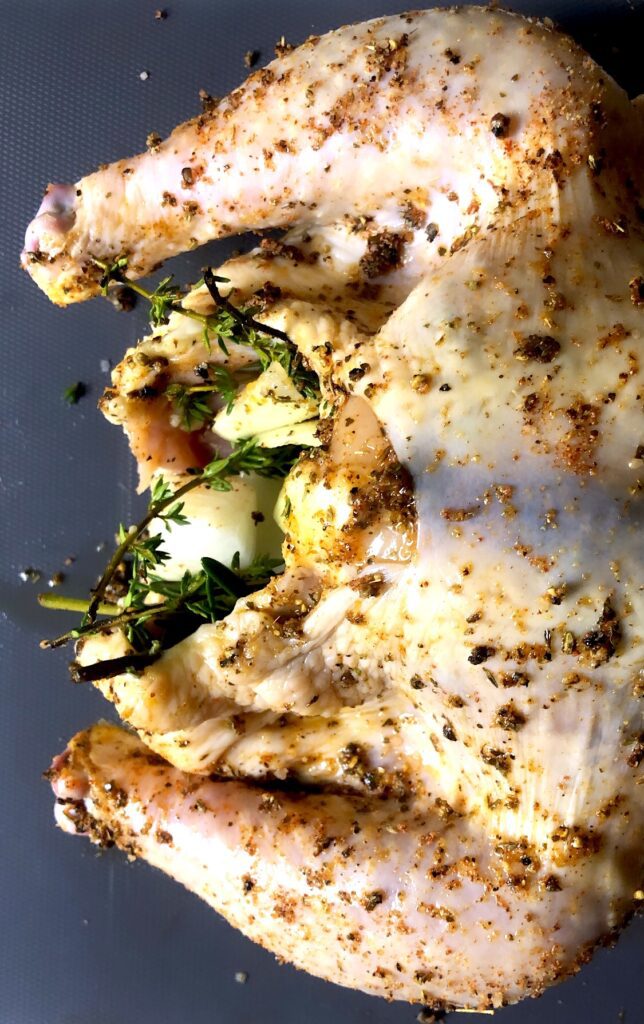
Step 1: Thaw chicken completely, if frozen
Take chicken out of the freezer and thaw it in the fridge for 24 to 48 hours. For a quicker thaw, place the whole chicken in a large bowl and cover it with cold water. Carefully replace the water every 2 to 4 hours until the chicken is thawed.
Step 2: Clean and trim excess skin/fat
All chickens are not equal when it comes to the ones we buy from our favorite grocery store. Some brands remove more of the extra fat and skin before sale than others, so just take a pair of kitchen shears and remove any excess fat or skin you may see. Also, remove any feathers that may be left on the chicken.
Another part that we remove is the tailbone. It’s just a small triangular-shaped part that can easily be cut off, even with regular scissors.
Step 3: Clean out cavity (sometimes this is already done)
Another part of prep that may vary is the contents of the chicken’s cavity. Remove any giblets from the inside and either dispose of them or save them for another use.
Step 4: Pat the chicken dry before seasoning
Any leftover moisture will prevent the oil (or butter) from doing its job – giving the chicken that crispy skin that we all love.
Step 5: Season the inside of the chicken
Sprinkle a liberal amount of the prepared dry rub inside the chicken. All that meat needs some love too!
Step 6: Stuff the inside of the chicken
Our favorite combination of flavors for the inside of a roast chicken is onion, lemon, fresh rosemary, and fresh thyme, but any number of aromatic ingredients can be used to flavor the chicken from the inside out.
Step 7: Rub oil/butter and seasonings all over the outside of the chicken (including under the skin)
Next are oil (or butter) and the dry rub seasoning. Some people like to make seasoned oil (or butter) that combines the two steps. Just thoroughly mix the dry rub into oil or butter and spread under and all over the skin.
Seasonings we use on every roast chicken (in pretty much equal parts):
- Kosher salt
- Ground black pepper
- Smoked paprika
- Garlic powder
- Onion powder
- Dried thyme and/or oregano
This is just our basic dry rub. To make the rub, add equal parts of each of these ingredients to a small bowl and mix until combined. Sometimes we throw in some finely minced garlic. Other times we use one of those flavored stir-in pastes (basil, ginger, garlic) to make the dry rub into a paste that we then spread all over the chicken.
Depending on the size of the chicken, there may be some dry rub left over, but no worries. It’s versatile enough to be used on any number of proteins and roasted vegetables. Feel free to adjust it by adding cayenne or red pepper flakes for heat or chili powder, ground ginger, or ground mustard, for some added flavor.
Any leftover dry rub can be stored in an airtight container. If there is leftover from using butter or a stir-in paste, it is best to dispose of them or store them in an airtight container and use them within 1 to 2 days. Any dry rub or paste that comes into contact with raw chicken should be disposed of immediately after use.
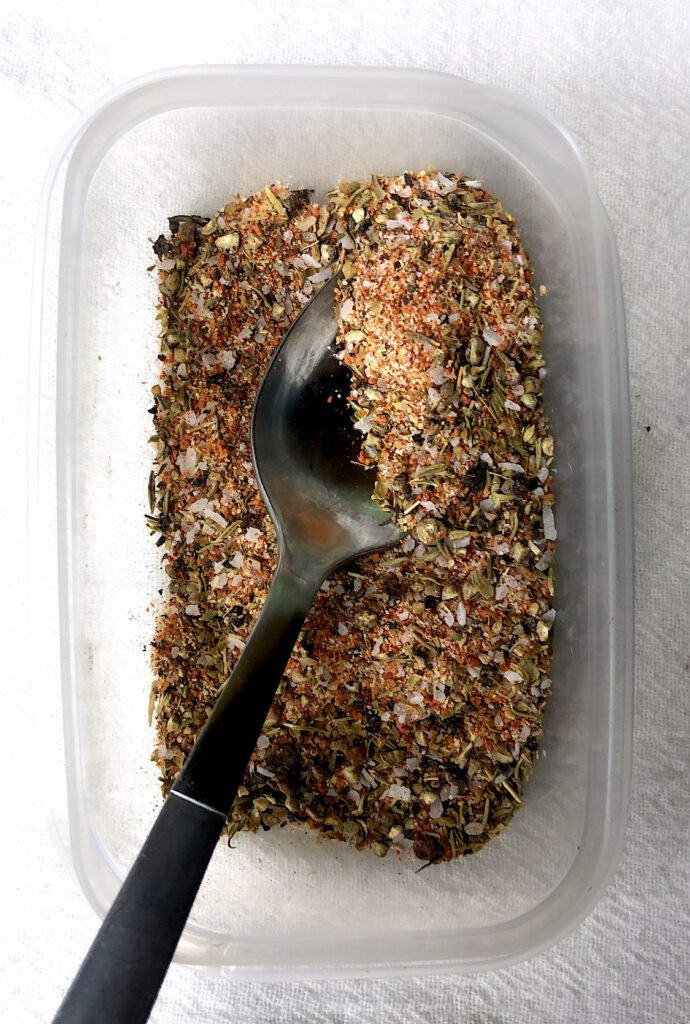
Step 8: Tie drumsticks together with kitchen twine
To keep all the ingredients inside and to keep the ends of the drumsticks from burning, use a piece of kitchen twine to tie the legs together. Trim any excess twine after the knot to keep this from burning in the oven.
Step 9: Tuck wing tips (or remove them completely)
For the same reason the drumsticks should be tied and the excess twine cut, the wingtips should be tucked into the side of the chicken or removed completely. There’s a running theme here: anything that is protruding from the chicken is likely cooking more quickly and will probably burn before the entire chicken is cooked.
Why roast on a rack
The roasting rack is used to elevate the chicken and get it up off the bottom of the pan. This is important because it allows the chicken (1) to cook more evenly and (2) to release excess fat in the form of drippings in the bottom of the pan.
I know you’re wondering why you’d want the fat aka flavor dripping out of the chicken, but there’s still plenty left inside the chicken for flavoring. Plus, the olive oil or butter and the seasonings have got you covered. The drippings are just the excess, meaning the fat that is left over after all of the meat has been juiced up and infused with all of that flavor.
Be careful to not overcook a chicken that is on a rack and uncovered (as in this recipe). It will be perfectly juice even though it is crispy outside as long as you don’t keep it in the oven for too long. Use an instant-read meat thermometer to ensure the chicken is 165º F in three places on the chicken:
- At the thickest spot on the thigh
- The inside portion of the wing
- The chicken breast
What is basting and how to do it
Another way to help prevent drying out your roast chicken is to baste it. Those cooking juices, melted butter, a glaze, or marinade can be brushed all over the meat to keep it moist and add flavor. A turkey baster can also be used to retrieve pan drippings from the bottom of the pan. You want to cover the entire surface of the meat with the liquid.
Other ways to jazz up your roast chicken
Make it cajun
Our favorite way to switch up a whole roasted chicken is to spice it up (all pun intended!) Add cayenne and/or crushed red pepper flakes to give it a kick. Make sure to include the dried oregano in the dry rub, and finish the chicken by giving it a few minutes under the broiler. This will give the chicken an extra crispy exterior without drying it out.
Roast chicken with root vegetables
Add quartered onion, carrots, potatoes, and other root vegetables to the bottom of the roasting pan with a little chicken broth or water. Season simply with salt, pepper, and maybe some fresh or dried herbs. The juices from the chicken cooking on top will help season the vegetables as well. At the end of the chicken’s cook time, the vegetables will be tender and delicious. You’ve just made an entire meal!
Spatchcock it
Spatchcocking a whole chicken involves cutting out the spine and cutting out a piece of the breast bone of the chicken in order to flatten it as much as possible. The tips of the wings are also removed since they are likely to burn before the chicken is cooked through. It may seem daunting at first, but spatchcocking a chicken has several benefits.
- Chicken cooks more evenly & reduces cook time: because the entire chicken is flattened and the surface area has increased, cook time is drastically reduced. Drastic, like a little over half the time it takes to cook it in the traditional whole roasted way.
- Increases surface area for seasoning: with more of the chicken exposed, seasoning can be sprinkled and stuffed into all of those places that can’t be reached when the chicken is still in tact.
- Crispy skin all over: since all of the chicken’s skin will be facing upward while it cooks, all of it will be delightfully crisp instead of just the top.
- No longer takes up the entire oven: roasting a whole chicken sometimes requires some oven rack rearrangement. You want it to be in the center for the cook to be as even as possible, but what if you also want to cook something else at the same time? Spatchcocked chicken takes up less space (heigh-wise), so you can potentially cook or warm something (like macaroni & cheese) on the rack below it.
- Adds a little razzle dazzle to the meal: serving a platter with a whole roasted chicken front and center is breathtaking in a very traditional (kinda stuffy) way. A spatchcocked chicken, on the other hand, displayed in the middle of a table surrounded by a variety of salads, vegetables, sauces, etc. really gives traditional, comfort food a modern, relatable, bold-and-open spin and takes the aesthetic up a notch!
How to carve a roast chicken
For a complete guide on how to carve a chicken: Taste of Home
For video of carving: YouTube
For video of the spatchcocking process: YouTube
Ways to stretch a roast chicken
- Chicken salad
- Use carved breast meat for sandwiches and wraps
- Remove skin and dice the meat to be used in soup
- Chicken pot pie
- Chicken pesto pizza or flatbread
- Use the chicken to make rice bowls or salads
Lemon Herb Roast Chicken
Equipment
- Cutting board and butchering scissors or knife
- Small mixing bowl
- Kitchen twine
- Roasting pan
- Rack for roasting pan
- Brush or bulb baster
Ingredients
- 1 whole chicken, thawed
- ½ yellow onion, cut into large pieces
- ½ lemon
- A few sprigs of fresh rosemary
- A few sprigs of fresh thyme
- 2-3 Tablespoons extra virgin olive oil
- 4 cloves garlic, minced finely
- ½ teaspoon Kosher salt
- 1 teaspoon Ground black pepper
- 1 teaspoon Garlic powder
- 1 teaspoon Onion powder
- 1 teaspoon Smoked paprika
- 1 teaspoon Creole seasoning
- ½ teaspoon Dried oregano
- ½ teaspoon Dried thyme
Instructions
- Preheat oven to 375º F.
- Clean and trim excess fat from chicken. Remove giblets and pat dry. Combine all seasonings and minced garlic into a dry rub and sprinkle about 1 teaspoon into the chicken’s cavity. Add lemon, onion, and fresh herbs to the cavity as well.
- Coat chicken all over with olive oil (or butter) then season liberally with more dry rub and garlic. Make sure to get every piece of skin and chicken that you can reach. Lift the skin of the breast and spread some oil (or butter) and seasonings there too. Tie drumsticks together with kitchen twine and tuck (or remove) wingtips.
- Place chicken on rack in roasting pan in the center of the oven. Cook for 45 to 60 minutes (about 15 minutes for every lb. of chicken) or until the internal temperature reaches 165º F, basting every 5 minutes for the last 20 minutes. Increase the temperature to 400º F and bake for 5-10 minutes or until the skin is crisp to your liking. Be careful not to overcook it.
- Let the chicken rest for 15-20 minutes after roasting, then carve and serve.

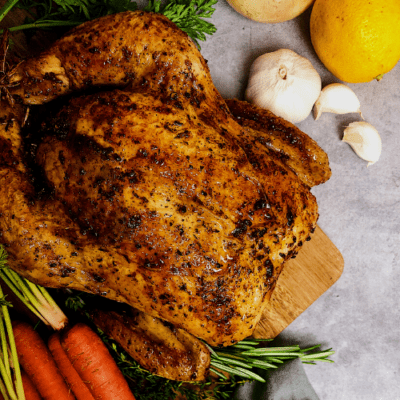
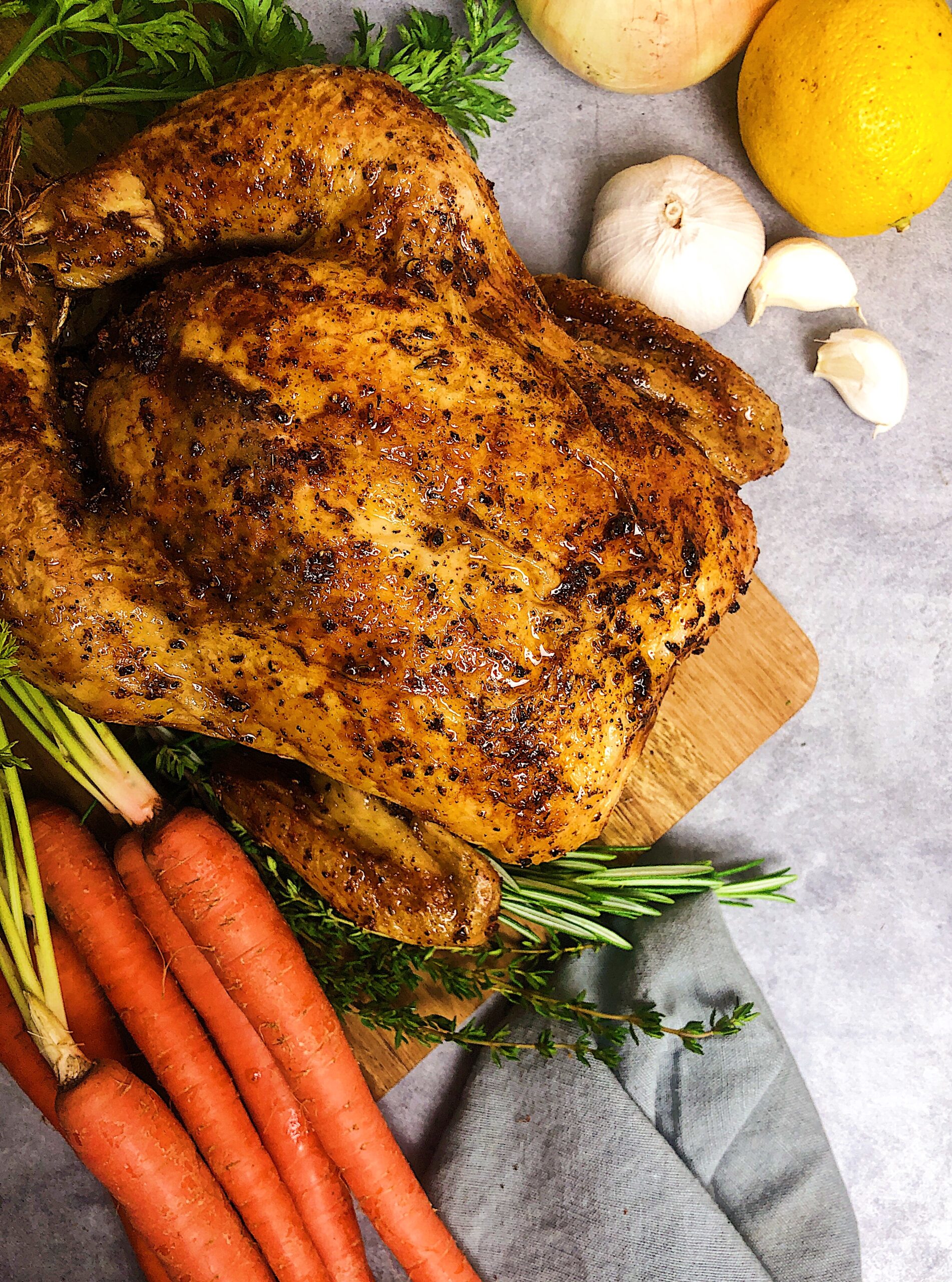
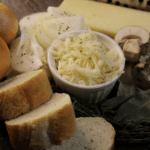

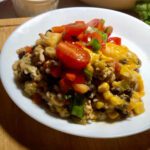
Leave a Reply